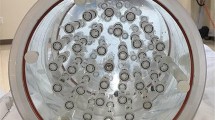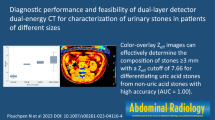Abstract
Computed tomography (CT) is useful for diagnosing biliary stones. However, the presence of stones not detected by conventional CT, such as iso-dense stones with CT numbers similar to those of bile or small stones, is problematic. Although conventional CT provides only 120-kVp images corresponding to CT numbers at approximately 70 keV, dual-layer spectral detector CT uses one X-ray source and dual-layer detectors to collect low- and high-energy data simultaneously; retrospective spectral analysis, including virtual monochromatic images with photon energy levels of 40–200 keV, material decomposition images, and spectral curves, can be immediately performed on demand. This technique can immediately discriminate between materials with similar conventional CT numbers. Therefore, prompt and accurate diagnosis of iso-dense stones can be performed. In two out of three of our cases, iso-dense stones were detected in virtual monochromatic images at 40 keV, but in the remaining case a common 4-mm bile duct stone was not detected on 120-kVp and 40-keV images by retrospective spectral analysis. However, this stone was detected by magnetic resonance cholangiopancreatography. Retrospective spectral analysis using dual-layer spectral detector CT was useful for prompt and accurate diagnosis of iso-dense stones, but detection of <5-mm stones may be a limitation of this technique and of conventional CT.



Similar content being viewed by others
References
Saito H, Kakuma T, Kadono Y, et al. Increased risk and severity of ERCP-related complications associated with asymptomatic common bile duct stones. Endosc Int Open. 2017;5:E809–17.
Tseng CW, Chen CC, Chen TS, et al. Can computed tomography with coronal reconstruction improve the diagnosis of choledocholithiasis? J Gastroenterol Hepatol. 2008;23:1586–9.
Kim CW, Chang JH, Lim YS, et al. Common bile duct stones on multidetector computed tomography: attenuation patterns and detectability. World J Gastroenterol. 2013;19:1788–96.
Anderson SW, Lucey BC, Varghese JC, et al. Accuracy of MDCT in the diagnosis of choledocholithiasis. AJR Am J Roentgenol. 2006;187:174–80.
McCollough CH, Leng S, Yu L, et al. Dual- and multi-energy CT: principles, technical approaches, and clinical applications. Radiology. 2015;276:637–53.
Tazuma S, Unno M, Igarashi Y, et al. Evidence-based clinical practice guidelines for cholelithiasis 2016. J Gastroenterol. 2017;52:276–300.
Williams EJ, Green J, Beckingham I, et al. Guidelines on the management of common bile duct stones (CBDS). Gut. 2008;57:1004–21.
Verma D, Kapadia A, Eisen GM, et al. EUS vs MRCP for detection of choledocholithiasis. Gastrointest Endosc. 2006;64:248–54.
Fernández-Esparrach G, Ginès A, Sánchez M, et al. Comparison of endoscopic ultrasonography and magnetic resonance cholangiopancreatography in the diagnosis of pancreatobiliary diseases: a prospective study. Am J Gastroenterol. 2007;102:1632–9.
ASGE Standards of Practice Committee, Maple JT, Ben-Menachem T, et al. The role of endoscopy in the evaluation of suspected choledocholithiasis. Gastrointest Endosc. 2010;71:1–9.
ASGE Standards of Practice Committee, Chathadi KV, Chandrasekhara V, et al. The role of ERCP in benign diseases of the biliary tract. Gastrointest Endosc. 2015;81:795–803.
Freeman ML, Nelson DB, Sherman S, et al. Complications of endoscopic biliary sphincterotomy. N Engl J Med. 1996;335:909–18.
Yang CB, Zhang S, Jia YJ, et al. Clinical application of dual-energy spectral computed tomography in detecting cholesterol gallstones from surrounding bile. Acad Radiol. 2017;24:478–82.
Li H, He D, Lao Q, et al. Clinical value of spectral CT in diagnosis of negative gallstones and common bile duct stones. Abdom Imaging. 2015;40:1587–94.
Chen AL, Liu AL, Wang S, et al. Detection of gallbladder stones by dual-energy spectral computed tomography imaging. World J Gastroenterol. 2015;21:9993–8.
Doerner J, Luetkens JA, Iuga AI, et al. Poly-energetic and virtual mono-energetic images from a novel dual-layer spectral detector CT: optimization of window settings is crucial to improve subjective image quality in abdominal CT angiographies. Abdom Radiol. 2017. https://doi.org/10.1007/s00261-017-1241-1.
Nagayama Y, Nakaura T, Oda S, et al. Dual-layer DECT for multiphasic hepatic CT with 50 percent iodine load: a matched-pair comparison with a 120 kVp protocol. Eur Radiol. 2017. https://doi.org/10.1007/s00330-017-5114-3.
Jendresen MB, Thorboll JE, Adamsen S, et al. Preoperative routine magnetic resonance cholangiopancreatography before laparoscopic cholecystectomy: a prospective study. Eur J Surg. 2002;168:690–4.
Rassouli N, Etesami M, Dhanantwari A, et al. Detector-based spectral CT with a novel dual-layer technology: principles and applications. Insights Imaging. 2017. https://doi.org/10.1007/s13244-017-0571-4.
Oda S, Nakaura T, Utsunomiya D, et al. Clinical potential of retrospective on-demand spectral analysis using dual-layer spectral detector-computed tomography in ischemia complicating small-bowel obstruction. Emerg Radiol. 2017;24:431–4.
Author information
Authors and Affiliations
Corresponding author
Ethics declarations
Conflict of interest
Hirokazu Saito, Kana Noda, Koji Ogasawara, Shutaro Atsuji, Hiroko Takaoka, Hiroo Kajihara, Jiro Nasu, Shoji Morishita, Ikuo Matsushita and Kazuhiro Katahira declare that they have no conflict of interest.
Human/animal rights
All procedures followed have been performed in accordance with the ethical standards laid down in the 1964 Declaration of Helsinki and its later amendments.
Informed consent
Informed consent was obtained from all patients for being included in the study.
Rights and permissions
About this article
Cite this article
Saito, H., Noda, K., Ogasawara, K. et al. Usefulness and limitations of dual-layer spectral detector computed tomography for diagnosing biliary stones not detected by conventional computed tomography: a report of three cases. Clin J Gastroenterol 11, 172–177 (2018). https://doi.org/10.1007/s12328-017-0809-1
Received:
Accepted:
Published:
Issue Date:
DOI: https://doi.org/10.1007/s12328-017-0809-1




